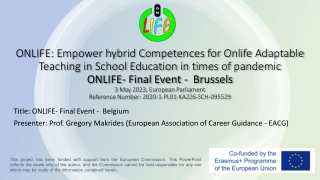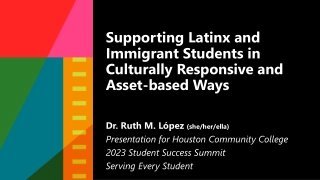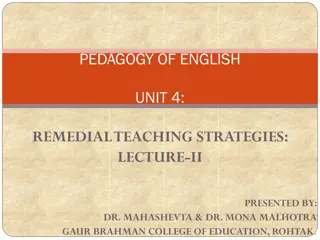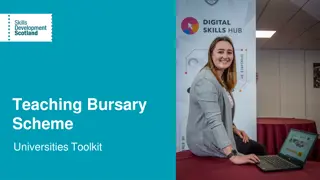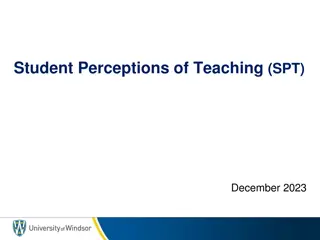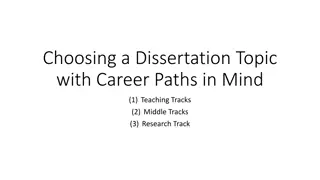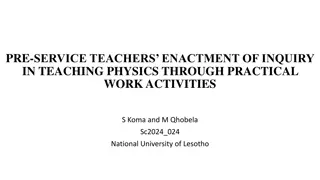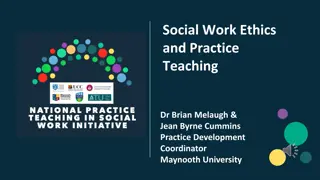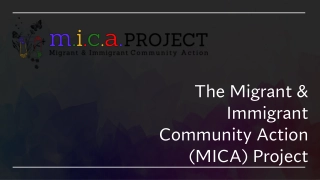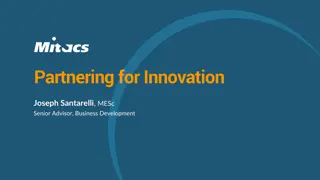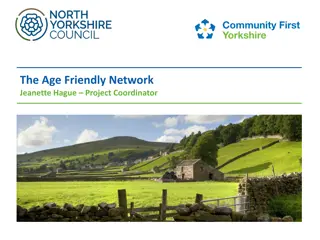Empowering Culturally Responsive Teaching
Learn to value students' experiences via active learning and culturally responsive strategies to close success gaps. Explore DEI guide, CRT principles, integration opportunities, and professional growth avenues.
Download Presentation
Please find below an Image/Link to download the presentation.
The content on the website is provided AS IS for your information and personal use only. It may not be sold, licensed, or shared on other websites without obtaining consent from the author. Download presentation by click this link. If you encounter any issues during the download, it is possible that the publisher has removed the file from their server.
Presentation Transcript
Active Learning and Culturally Responsive Curriculum Practices (Online) Friday, July 8, 10:45 AM-12:00 PM, Fully Online Presenters: Karen Chow, ASCCC Area B Representative Amber Gillis, ASCCC South Representative Michelle Pacansky-Brock, Foothill De Anza District & CVC/@ONE Eric Wada, ASCCC North Representative
Breakout Description Valuing our students excellence and understanding that our students learn and demonstrate their learning better in culturally sensitive learning environments is central to an institutional framework of inclusion, diversity, equity, and anti-racism necessary for closing the success and persistence gaps for disproportionately impacted student populations. In a culturally sensitive environment, students prior learning and authentic lived experiences are central to the design of instruction. Learn how to use active learning and culturally responsive teaching strategies to support student engagement. 2
Objectives 1. Explore the new Guide for Diversity-Equity-Inclusion (DEI) in Curriculum. 2. Examine Culturally Responsive Teaching (CRT) principles. 3. View examples of CRT in different disciplines and modalities. 4. Consider opportunities for integrating CRT into the curriculum review process. 5. Identify professional development opportunities to further your DEI growth.
New Guide for DEI in Curriculum Transform traditional practices by applying equity principles Explore culturally responsive classroom practices Identify practices for curriculum committees and local senates Get Your Own Copy!
Culturally Responsive Teaching Principles
Culturally Relevant Teaching Culturally Responsive Teaching Uses the cultural knowledge, prior experiences, frames of reference, and performance styles of ethnically diverse students to make learning more relevant to and effective for them (p.36) Recognizes a student s past, present, and future as the context of their learning. Focus is on what improves the lives of the students, families, and communities they serve... (p. 36) Validating, multidimensional, empowering, transformative, emancipatory Ladson-Bilings, G. (2006). Yes, but how do we do it? Practicing culturally relevant pedagogy. In Landsman, J. & Lewis, C., Eds. (2006). White Teachers/Diverse Classrooms. Stylus Publishers. Gay, G. (2018). Culturally responsive teaching: Theory, research, and practice. New York: Teachers College Press. Slide by Michelle Pacansky-Brock, CC-BY-NC
Culturally Responsive Teaching reduces cultural mismatches. Incorporate: Real world connections & students life experiences Metaphors Aural storytelling (speaking) Use Flipgrid (free) or VoiceThread (if your college has a license) or Canvas voice/video Discussions Cooperative learning Photo by Nikita Taparia on Unsplash Slide by Michelle Pacansky-Brock, CC-BY-NC
Reduce Cultural Mismatches Collectivist High Context Individualistic Low Context Identity is rooted in oneself and accomplishments Identity is rooted in groups (family, culture, work) How it is said is less important than what is said How it is said is more important than what is said Competition over cooperation Cooperation over competition Individual effort is important in business and learning Relationships are essential to business and learning Efficiency and speed are valued Accuracy and depth of understanding are valued
Individualism-Collectivism Continuum Created by Geert Hofstede, cultural anthropologist. Higher scores represent more individualistic values, lower scores convey more collectivist values. Country Score Country Score Country Score Country Score Country Score Jamaica 39 Germany 67 United States 91 Tanzania 27 Thailand 20 South Africa 65 Brazil 38 Ethiopia 27 El Salvador 19 Australia 90 Finland 63 Egypt 38 United Kingdom 89 Kenya 27 South Korea 18 Poland 60 Iraq 38 Netherlands 80 Portugal 27 Taiwan 17 Czech Republic 58 Kuwait 38 New Zealand 79 Zambia 27 Peru 16 Lebanon 38 Austria 55 Italy 76 Malaysia 26 Costa Rica 15 Saudi Arabia 38 Hungary 55 Belgium 75 Hong Kong 25 Indonesia 14 Israel 54 United Arab Emirates 38 Denmark 74 Chile 23 Pakistan 14 Spain 51 Turkey 37 France 71 China 20 Colombia 13 India 48 Uruguay 36 Sweden 71 Ghana 20 Venezuela 12 Argentina 41 Greece 35 Ireland 70 Nigeria 20 Panama 11 Philippines 32 Japan 41 Norway 69 Sierra Leone 20 Ecuador 8 Mexico 30 Iran 41 Switzerland 68 Singapore 20 Guatemala 6
Individualism-Collectivism Continuum North, Central, and South American countries are highlighted in yellow. Country Score Country Score Country Score Country Score Country Score Jamaica 39 Germany 67 United States 91 Tanzania 27 Thailand 20 South Africa 65 Brazil 38 Ethiopia 27 El Salvador 19 Australia 90 Finland 63 Egypt 38 United Kingdom 89 Kenya 27 South Korea 18 Poland 60 Iraq 38 Netherlands 80 Portugal 27 Taiwan 17 Czech Republic 58 Kuwait 38 New Zealand 79 Zambia 27 Peru 16 Lebanon 38 Austria 55 Italy 76 Malaysia 26 Costa Rica 15 Saudi Arabia 38 Hungary 55 Belgium 75 Hong Kong 25 Indonesia 14 Israel 54 United Arab Emirates 38 Denmark 74 Chile 23 Pakistan 14 Spain 51 Turkey 37 France 71 China 20 Colombia 13 India 48 Uruguay 36 Sweden 71 Ghana 20 Venezuela 12 Argentina 41 Greece 35 Ireland 70 Nigeria 20 Panama 11 Philippines 32 Japan 41 Norway 69 Sierra Leone 20 Ecuador 8 Mexico 30 Iran 41 Switzerland 68 Singapore 20 Guatemala 6
Dependent Learner Independent Learner Unsure about how to tackle a new task Needs scaffolds to complete tasks Will sit passively and wait if stuck until the teacher intervenes Possesses cognitive strategies for getting unstuck Attempts new tasks without scaffolds Has learned how to retrieve information from long-term memory Hammond, Z. L. (2014). Culturally Responsive Teaching and the Brain: Promoting Authentic Engagement and Rigor Among Culturally and Linguistically Diverse Students. Corwin Publishers.
Warm Demander Competencies Warm demander describes a culturally responsive pedagogy that develops intellectual abilities in dependent learners through cognitive struggle. Based on research about effective teaching approaches for Indigenous students. 1. The ability to create a climate of emotional warmth that dissipates students' fears and fulfills their expectations of highly personalized relationships. 2. The ability to express concern for students, not by passive sympathy, but by demanding a high quality of academic work. Kleinfeld, J. (1975). Effective teachers of Eskimo and Indian students. School Review, 83, 301 344.
Warm Demander Pedagogy A culturally responsive teaching pedagogy that develops intellectual abilities in dependent learners through cognitive struggle. Based on research about effective teaching approaches for Indigenous students. Expresses personal warmth vs. impersonal professionalism Shows personal regard for students Earns the right to demand engagement and effort Prioritizes building rapport and trust Clearly communicates high standards and scaffolds learning Encourages and celebrates productive struggle Kleinfeld, J. (1972). Effective Teachers of Indian and Eskimo High School Students. Institute of Social, Economic and Government Research, University of Alaska Kleinfeld, J. (1975). Effective teachers of Eskimo and Indian students. School Review, 83, 301 344.
Culturally Responsive Teaching Examples
Principles & Practices: Example 1 Traditional Education Practice Equity Principle Culturally Responsive Classroom Practices Culturally Responsive Practices for Curriculum Committees & Local Senates Build on diverse backgrounds to engage as a familia, tribe, or village through collaborative classroom activities. Encourage assignments, practices, and assessments that are formative in addition to summative. Cultural experiences, assignments, and assessments are built from an individualistic perspective Shift to a collectivism perspective to engage authentic lived experiences and relate to students cultural norms Review for a variety of methods of evaluations, assignments, and assessments. Be a warm demander and co- learner with students. Intentionally create collaborative engagement opportunities (e.g., group work, peer-to-peer work, pair shares, etc.). Encourage and provide professional development for the creation of authentic assessments.
Application of Principle/Practices to History of Photography Traditional Education Practice Equity Principle Culturally Responsive Classroom Practices Create a camera obscura using a Pringles can. Record/photograph yourself or a family member using it or capture the image you see. Upload your documentation into VoiceThread. Leave a voice comment on one peer s post. Shift to a collectivism perspective to engage authentic lived experiences and relate to students cultural norms Assessments are quizzes and exams that involve identification of photographs (artist, title date), significant technological advancements, written analysis (compare/contrast). Talk to your relatives and locate your oldest family photograph. Some of you will find very old photographs and others will find photographs that are more recent. These differences are representative of our family s pasts. Upload your photo to VoiceThread and tell us the story of the person/people. Comment on two posts, sharing a difference or commonality you share with your classmate.
Student camera obscura documentation using VoiceThread (shared with student permission). Slide by Michelle Pacansky-Brock, CC-BY-NC
Application of Principle/Practices to Textbooks in Humanities Traditional Education Practice Equity Principle Culturally Responsive Classroom Practices One dominant culture represented in textbooks and course materials. Represent multiple cultures in textbooks and course materials. Textbooks on Western European art and humanities traditionally represent male-dominated, white-centric, elitist ideals and products (completed art pieces). Additionally, they are generally very expensive. Opportunities: Including women Highlighting artists that challenged the status quo Discussing history from an honest and inclusive perspective where social structures and societal norms are investigated critically If the COR includes a connection between traditional and modern art, highlight BIPOC interpretations of traditional art
Michelangelos La Pieta and Coxs Yo Mamas Pieta La Pieta, 1498-99 Yo Mama s Pieta, 2001
Application of Principle/Practices to EWRT 1A (Freshman composition) Traditional Education Practice Equity Principle Culturally Responsive Classroom Practices Center BIPOC authors/experiences in textbooks and course materials. Ex: Textbooks: Heart of Fire: An Immigrant Daughter s Story by Mazie Hirono One dominant culture represented in textbooks and course materials. Represent multiple cultures in textbooks and course materials. Low-cost and zerocost Textbooks/materials by BIPOC author: 3 PDF (free) chapters from Alicia Garza s book The Purpose of Power, used by permission of the publisher. These chapters were also part of a campuswide One Book initiative that multiple disciplines courses/faculty participated in, culminating in a campus Zoom booktalk/Q&A with Alicia Garza, facilitated by students. High cost of course textbooks and materials. Use low-cost and zerocost textbooks/materia ls
Equity-minded Liquid Syllabus Emailed to students before the class starts. Recommended Components: Welcoming, hopeful language Welcome note with brief, imperfect video and accurate captions About This Course Week 1 Success Kit Learning Pact Teaching Philosophy that positions diversity as a value Inclusive images (with alt-text) Michelle s Liquid Syllabus Michelle Pacansky-Brock, Mt. San Jacinto College Michelle Pacansky-Brock, CC-BY
Lets Share! Please contribute to our Padlet so we can learn together Click here to go to the Padlet OR scan this code on your phone/tablet:
Integrating Culturally Responsive Teaching into the Curriculum Review Process
Elements of a Course Outline of Record (COR) (Title 5 55002) The course is described in a course outline of record that shall be maintained in the official college files and made available to each instructor. The course outline of record shall specify the unit value, the expected number of contact hours, outside-of-class hours, and total student learning hours for the course as a whole; the prerequisites, corequisites, or advisories on recommended preparation (if any) for the course; the catalog description, objectives, and content in terms of a specific body of knowledge. The course outline of record shall also specify types or provide examples of required reading and writing assignments, other outside-of-class assignments, instructional methodology, and methods of evaluation.
Curriculum Committee and Culturally Responsive Teaching Committee membership: How is membership determined? How are students involved? Curriculum Committee training & periodic check-ins Opportunities to re-center discussions When in the process do reviews of content, objectives, assignments, texts, and evaluation methods occur? Resources and rubrics
Culturally Responsive Teaching: Beyond the Curriculum Committee Department faculty initiate curriculum development and review Departmental discussions of culturally responsive teaching Discussions can encourage professional development Include part-time faculty (new and experienced) Course outline provided to new faculty Provides ideas for how to embed active learning and culturally responsive teaching into the conduct of the course. Sets culturally responsive teaching as a norm in education.
Professional Development from CVC/@ONE CVC/@ONE is a CC Chancellor s Office-funded initiative. Courses are designed and facilitated by CC faculty. Continuing ed units (CEUs) are available for an additional fee. PD in support of equitable, inclusive online courses. New! Learn more: https://onlinenetworkofeducators.org/course- cards/
Lets Discuss/ Q&A Q&A Please share: What additional information/ideas do you have to contribute to this breakout topic/discussion? 30
Thank you for participating! For more information: info@asccc.org 31







